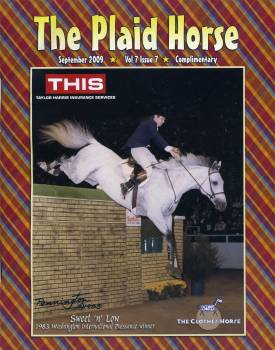by Tonya Johnston, MA
appeared in The Plaid Horse, September 2009
You jump the last fence in your course and make your closing circle. As the applause dies down (yes, there was lots of whooping and clapping) you exit the ring giving your horse a pat on the neck. What happens next? Obviously the five minutes after you come out of the ring are very much driven by your trainer, but, like many things in riding, there are a lot of opportunities to support, encourage and teach yourself as well.
As your trainer debriefs the course with you, you are also reviewing your effort. If you have another round right away this process will of course differ slightly than if you do not. Either way, there are strategies you can employ to cement the good things and lock in the lessons that you would like to embrace in the future. We discussed your pre-ride routine for the back gate in Part 1; now we will look at some ideas that can be a consistent part of your post-ride routine in Part 2.
Find the Gems First
Whether your ride was fantastic and full of ‘Wow’ moments, or not so great and full of ‘Oops’ experiences, there are virtually always pieces that you can be proud of. When you come out of the ring, take a deep breath to gather yourself and allow a brief period of reflection. Find the gems first by identifying the best moments of your course – along with why they occurred. For example, what performance goals did you accomplish? The benefits of this process are two-fold. First, a post-ride routine that includes looking for the great moments creates a positive expectation before you begin. In effect you will have ‘primed the pump’ – which means you will have done something to ensure your success. Second, by examining what went right first you are strengthening the habits that led to those moments, thus improving the chance that they will happen again.
Craft Solutions Where Necessary
If there were some mistakes on course, allow disappointment to have a time and place, but keep moving through the experience. It is unrealistic to think a “Drat!!” or “Argh” won’t flash through your mind after a particularly unfortunate error. So, acknowledge your disappointment, then go quickly into ‘problem-solver’ mode (your trainer will be a big part of this process).
Instead of focusing on the mistake itself (“We stopped at the single oxer again!”) try to look at why it happened (“I looked down and tipped my upper body.”) then craft the solution (“I will keep my eye up on the middle of the front rail and open my chest at the single oxer next time.”). As a result of this process you will have found a succinct and realistic solution that you can focus on. Then, instead of replaying the mistake, replay how the solution will feel the next time you jump a single oxer with finesse and flair.
Visualize Successes Immediately
After coming out of the ring, have you ever noticed yourself replaying your mistakes over and over again in your head? Do you know what kind of effect that has on your mind and body? What you are doing is strengthening the likelihood of more mistakes, wasting your energy and a solidifying a gloomy attitude. Focus instead on those truly magical moments on course where you felt completely focused, smooth and in sync with your horse.
It is true that dedication, determination and perseverance may be required to help you visualize the best memories once you complete a round that also contained mistakes.
Why work so hard? Recreating the great parts of your ride strengthens the muscle memories that led to those successes – making it more likely you will repeat your finest moments. As you run through them again, also try to recapture the positive emotions in order to ‘stamp’ them as helpful and encouraging experiences and those aspects of your riding will be further reinforced. The effort required will be well worth it with not only successful habits being built, but significant deposits being made into your bank of confidence.
Take Post-Ride Notes
Once you are back at the barn (not technically at the back gate anymore – but this is a valuable debriefing strategy worth mentioning) tracking your rides and courses can be a great way to reinforce the good, and learn from the not-so-good. Create a regular template for: writing down your course, remembering your preparation, specifying the goals you accomplished, and the things to improve (and how to improve them) and you are sure to make your horse show experiences work for you. Ideally you will take five minutes sometime after your ride to jot down these details, no matter how briefly, so that you can remember the keys to your success (and/or future success!). The act of writing them is also valuable as they will also create an encyclopedia of your skills and achievements to reflect back on in the future.
As you strive to be the best rider you can be, remember that your effort and progress need to be rewarded and acknowledged by someone very important – you! Never ignore an opportunity to give yourself a pat on the back when you come out of the ring, and recognize the constant development of your talents.
Tonya Johnston, MA, is a Mental Skills Coach who specializes in working with equestrian athletes. Her coaching sessions teach mental strategies for optimal sport performance and help riders develop personalized preparation routines. Tonya’s clients have attained competitive success at every level, including national titles and awards. She has presented at both the USEA and USDF national conventions. Tonya has a master’s degree in Sport Psychology from John F. Kennedy University. She conducts “Mental Skills for Riders” clinics throughout the country as well as phone consultations with individual clients. Phone: 510.418.3664. www.TonyaJohnston.com


